Subversive jewellery
Challenges to conservative power from the Victorian goldfields
by Linda Young
Introduction
This story begins with exotic dancer Lola Montez, who joined the gold rush to Australia in 1855–56 from her home in California. She spent two years entertaining men on the colonial goldfields and major cities with artistic performances that culminated in her famous ‘spider dance’, in which she appeared ever more frantic to shake a spider from her skirts. Diggers showered her performances with nuggets. She was also presented with gold jewellery: among the pieces, a huge oval-shaped gold brooch, inscribed on the back, ‘Presented Melbourne Dec. 28 1855 to Madame Lola Montez by her Friends in Victoria as a proof of their esteem’.
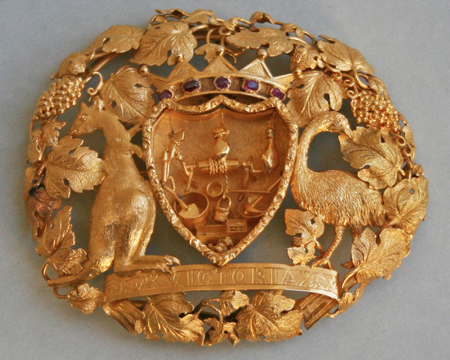
Private collection
courtesy John Wade, Australiana society
It is the only piece known to survive of a cache of Australian gold jewellery that Montez sold the next year in San Francisco, and is now in a private collection.[1]
Stylistically, the brooch is a conventional contemporary form, with a central panel densely wreathed in vine leaves. But the panel motifs are not conventional at all, focusing on a shield decked with the implements of gold-getting: pick, shovel, bucket, windlass, cradle; and some necessities of the gold-digging life: a pistol, a leather pouch for gold nuggets, and a leg of meat. The shield is surmounted by a crown, and supported by a kangaroo and an emu, a pair employed in informal Australian symbolism since the 1820s. They stand on a scroll engraved ‘VICTORIA’, the location of the world’s richest gold rush to that time.
Clearly, the brooch constitutes a narrative of digger pride. The tools of trade proclaim the source of the golden wealth that commissioned the brooch, literally foregrounding the means of its production. The native animal motifs assert its Australian frame. While nationalist imagery is not unknown in mid-Victorian jewellery,[2] manual tools such as pick and shovel are quite absent from both popular and polite jewellery of the nineteenth century.
Montez’s brooch is not unique. Two, of more purely figurative design and equally large, are in public collections, and (to my knowledge) some seven smaller brooches of similar form have been acquired by museums and private collectors. Montez sold six more brooches described as ‘massive’ and ‘beautifully wrought’, which may have been similar, or may have featured Australian native flowers, as known in other contemporary museum pieces.[3] A more attenuated brooch form emerged in the 1890s on the Western Australian goldfields: a simple crossed pick and shovel, with a repertoire of variations.[4] That style was made at the same time on the Alaskan and South African goldfields, and though the chronology and direction of its trans-oceanic movement is not clear, the spread demonstrates the global reach of digger culture.
This article contends that in the history of the Montez and similar brooches of the 1850s–60s can be discerned a claim to social recognition carried into the formation of post-gold rush middling society. Analyses of the social outcomes of the gold rushes in Victoria agree that the demographic impact in numbers and human capital was critical to the development of Victoria, introducing a young, skilled labour force.[5] How the ethos of gold digging created a confident constituency whose political pressure prefigured Australian democracy is variously interpreted, but broadly assented.[6] In this, the petit bourgeois aspirations of most diggers have been decried as blocking the formation of a self-conscious working class.[7] But class analysis has hardly been applied to the trajectories of those who engaged in commerce and industry to service the diggers and ex-diggers, in favour of impersonal accounts of growth.[8] Thus the emergence of humbler lives of small property-ownership and domestic respectability that also took shape out of the gold digger experience, have rarely been explored. An irony of the domesticating process is that it ineluctably undermined the flagrant glory of gold jewellery — which perhaps funded a newly comfortable class. This is the segment ST Gill depicted in The Lucky Digger that Returned: a happy father playing with his child on the parlour sofa while his wife reads in the background, with a modest hint of gold around her neck.
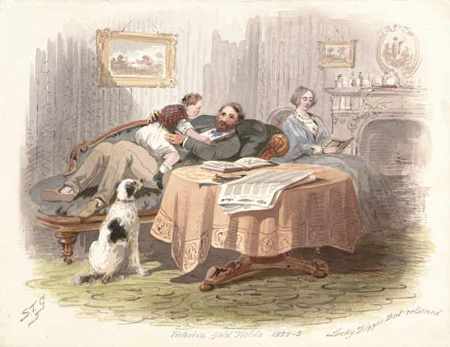
by ST Gill
State Library of Victoria, SLV: H86.7/40
My argument is based on the agency of material objects in social relations, as expressed in the proposal of Mary Douglas and Baron Isherwood that ‘goods are needed for making visible and stable the categories of culture’.[9] This insight suggests how the digger jewels assert that a lucky find made on the goldfields demanded the respect that wealth normally guaranteed, whomever it attached to — here is the source of the ‘subversion’ referred to in the title. Every man arrived an equal new chum at the goldfields of the 1850s, where it was often noted that the refined and the rough, the educated and the illiterate, worked side by side in mutual ambition. The digger brooches acknowledge little of taste or fashion (though mainstream fashionable forms were imported to and manufactured in Melbourne and the goldfield towns at the same time). Instead they contested the orthodoxy of precious jewellery in its traditionally elite sphere by mobilising finely worked precious metal on the breasts of diggers’ women to signify the achievements and consequent demands for acknowledgement of masculine luck and labour. The transition of diggers from the raucous culture of the goldfields to urban and suburban respectability may explain the long-hidden survival of these unorthodox jewels.
The case is built on three propositions applied in the conditions of the Victorian gold rush in the 1850s. The first is that jewellery mediates a politics of worth and value. Hence I show how diggers had their finds wrought into jewels that explicitly celebrated their luck and labour, proclaiming new identities by challenging the elite traditions of gold jewellery. The second proposition is that gifts of jewellery perform in the public sphere as gendered signs of the female expression of male power, and in both public and private spheres as erotic spectacle. The history of Montez’s and the other digger brooches is explored to make this point. The third proposition is that the precious and spectacular can transmute into the values of everyday life in an exchange of the economic capital of gold for the social capital of respectability. Here I return to the larger argument about the conditions that shaped the formation of post-gold rush civil society in the colony of Victoria. But to begin, the context.
Gold rush to Victoria, 1851
In pre-modern times, gold mines were tightly controlled by state powers, a situation that changed with the great mid-nineteenth-century discoveries in the United States (1849) and Australia (1851). California, New South Wales and Victoria were remote, barely governed territories. Their populations had evolved such that many workers achieved a high degree of individual agency in directing their labour, rare in the surging industrial capitalist economies of the United States east coast and urban Britain.
At the turn of the 1850s, mythic tales spread of rivers of gold and plains where nuggets could be picked up off the ground. They inspired hundreds of thousands of men to seek their fortune in what became a half-century of international gold rushes. World maritime transport routes from the old world to the new were already well established, thanks to the experience of a century of voluntary and coerced emigration. A rush of diggers could be delivered halfway round the globe from the United Kingdom or the east coast of the United States in just a few months. Gold-getting was a low-technology business, and even if it was not as simple as scooping it out of the ground, all it required were basic tools, strength and perseverance. Hence it presented an unprecedented opportunity for a young man with practically no capital except a ship’s passage to kit up and take off for the diggings.
The mystique of a lucky gold strike impelled nearly 300,000 men and 200,000 women to make the arduous trip to the colony of Victoria in the 10 years following the first finds in 1851.[10] Some struck it rich — though not many. Large fortunes were made in the first years, when the solo digger or a small team of mates could work alluvial gold deposits that were accessible by manual labour with pick and shovel. Thereafter, the most productive gold mining shifted to strata so hard and deep that it required highly capitalised, industrial technology worked by waged miners; the potential for wealth shifted to investors. Nonetheless, small prospectors continued to work claims throughout the 1850s. The most consistent profits on the early goldfields were made by merchants and carriers, who could charge inflated prices for both necessities and luxuries.[11] But this truth failed to infiltrate the global fantasy of setting off to the Victorian diggings to find one’s fortune.
The reputation of the lucky digger transformed the international image of the Australian colonies from a sink of convict depravity to a land of opportunity. Some two-thirds of diggers stayed on in Australia even if (or because) they didn’t make fortunes, for life in the colony of Victoria had much to offer by comparison with the old world.[12] The transition from diggers to civilians was belatedly assisted with rural land schemes by a government dominated by pastoralist interests, but most ex-diggers fell into work (or poverty) in the expansive towns and cities of the colony, where some version of domesticity called. As time passed they began to remember the ‘roaring days’ with inventive nostalgia. The gold rush had already generated a legend of the rough-living, resourceful, egalitarian digger, whose experience emerged again to unify the ‘diggers’ of the AIF in the First World War.[13] A suite of oppositions inhabited both eras of digger, rough but true-hearted, solo but matey, unlearned but canny — the characteristics of the common man. The gold rush put many common men in the way of gold, and that is the engine of this argument.
The value of gold
The widespread (though not universal) value of gold derives from its natural qualities: scarcity, workability and endurance, which make it highly suitable as a bearer of incarnate value in the form of coin money. Money liberates trade from barter, and it was opportunities for global investment that drove Britain’s shift from a silver to a gold standard in 1821, stabilising investors’ risk. But for trade to increase, the money supply had to increase. The mid-nineteenth-century gold rushes fortuitously augmented the world’s money supply.[14] Connected to this economic identity are the symbolic meanings attributed to gold in themes of perfection and purity, which endow it with magical numen. The value of gold is also historically generated by the social and political relationships it mediates, which have cast gold as the material substance of social as well as financial power.[15] Thus the aura of gold contains a cultural significance that gilds its perceived value.
Possessing (enough) gold makes a person rich. Gold that is surplus to exchange needs can be hoarded in ingots or displayed as jewellery; both are traditional forms of wealth in many cultures, easily converted into money if needed.[16] The lure and the shock of the gold rush was the outcome that common men with gold had to be acknowledged as rich, with at least the potential for power, thus introducing the politics of gold jewellery. The ways Victorian diggers invested their gold-wealth are summarised in a pair of moralising watercolours by ST Gill: The Provident Digger and The Improvident Digger.[17]
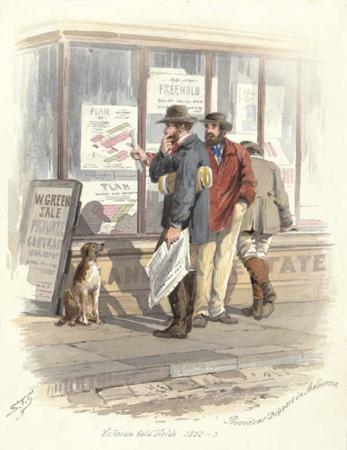
by ST Gill
State Library of Victoria, SLV: H86.7/35
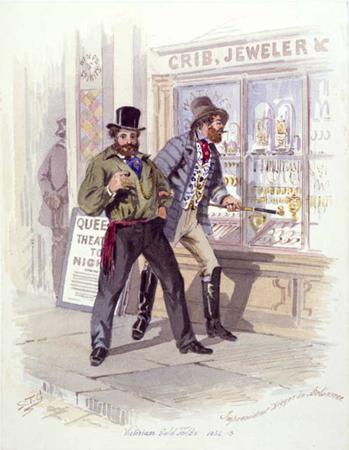
by ST Gill
State Library of Victoria, SLV: H86.7/36
The former purchased land; the latter bought jewellery and other gewgaws. The provident potential of land ownership is personal independence, which featured prominently in diggers’ letters home as a goal of the gold rush adventure. The respectable morality of buying land contrasted with the flashy, extravagant implication of buying jewellery. Economically it was equally rational, but it challenged and offended the delayed-gratification ethic of conventional society, which was more genteel than aristocratic.[18]
By 1853 the Victorian gold rush had created a burgeoning consumer market for luxuries. Prestige commodities such as high quality firearms, horses and carriages were joined by jewellery; some 30 practising jewellers and goldsmiths have been identified working in Victoria in the 1850s.[19] The well, though informally, dressed diggers in Gill’s watercolours flaunt the masculine jewellery of the time: watches hinted at by heavy gold watch chains, cravat pins and, on the pipe-holding hand of the near digger, a prominent gold ring. There are many more documentary hints about the popularity of ‘big colonial rings’ than there are surviving examples, which may well prove the truth of their ready metamorphosis into cash. One is described in an 1855 advertisement: ‘A ring of pure colonial gold is so contrived as to show, in separate compartments, small specimens from the different goldfields in its native nuggety form’.[20] The only Australian digger ring known is similar to this description.
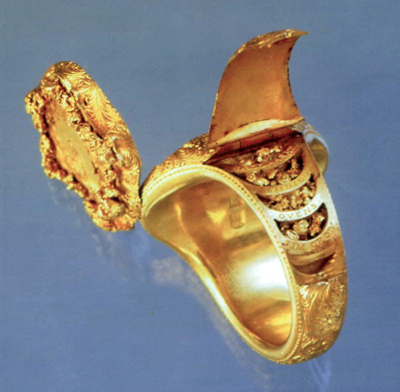
Museum of Applied Arts, Budapest
This ring is speculatively connected to Queen Victoria’s son, the Duke of Edinburgh, who visited the colonies in 1867–68 and was presented with a number of elaborate rings in Bendigo.[21] If it is his, he may have preserved the ring as a curiosity, in his later life as Duke of Saxe-Coburg-Gotha.[22] Ostentatious jewels such as the rings made assertive metaphors for the power of wealth, deployed via the poetics of visuality to attract attention. As Marcia Pointon notes, jewellery’s function is to focus the attention of viewers, to be looked at.[23]
But the scopic environment of the Victorian goldfields and Melbourne in the 1850s was, to put it mildly, dissonant in the conventional sphere of precious jewellery. A common man wearing a spectacularly valuable ring presented a shocking contradiction of the natural order of things as understood by the genteel of the colony; in London, he might have been suspected of stealing it. Ostentation was a sin of inappropriate grandeur among the middle class, let alone the working class. This is why a lavish ring could be given to a royal prince — kings were meant to own gold, and the radiant substance enhanced his power appropriately. The diggers whom Gill captioned ‘improvident’ transgressed dominant taste, morality and class relations with their swagger. Their conspicuous jewels manifested the new social relations generated by the gold rush: ‘There are no gentlemen in the colonies now … All barriers are broken down. There are only rich men and poor men; and as the latter may be rich within a week, everyone is “hail fellow, well met” with everyone else’.[24]
Gold jewellery as gift
The brooch given to Lola Montez, and the eight other brooches, introduce a different category of gold digger art: jewellery for women. The presumption that jewellery has a significant aesthetic dimension is challenged by the formal incongruity of this genre.
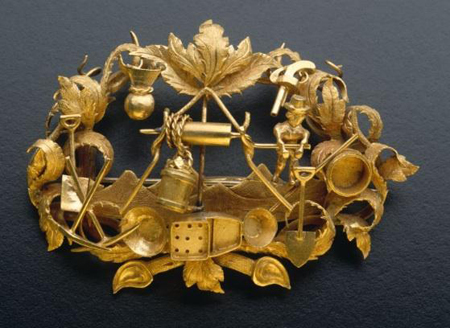
Powerhouse Museum, Sydney, A9876
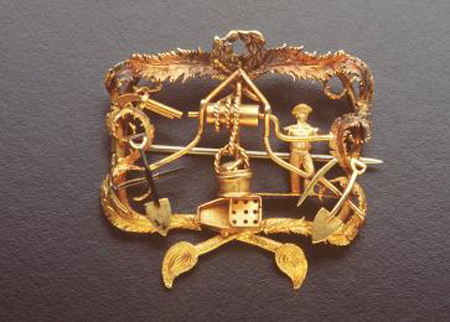
Powerhouse Museum, Sydney, A4478
Its major feature is a figurative composition of freestanding miniature elements. The central motif is a tiny man working a windlass wound with golden wire from which hangs a bucket or a small nugget. He is flanked by an assortment of digger tools: usually, two pairs of crossed picks and shovels, a dirt-washing cradle, a washing pan or tub, a long-handled crucible, a gold pouch and a pistol. (This iconography was prevalent in the popular visual lexicon of imaging the goldfields from the earliest years of the Victorian rush, that is, in broadsheet illustrations and banners.) The composition is generally encircled by a frame of flowery acanthus or vine leaves, the only customary mid-nineteenth century brooch component, as might be seen framing a brooch with a precious stone or a photograph. Montez’s brooch and two of the others are very large, at 8 centimetres wide; the others are between 4 and 6 centimetres wide. Some of the brooches are marked with makers’ initials, but despite the catalogue of known goldsmiths, none has been specifically identified. Two (including the Montez brooch) are decked with scrolls engraved respectively, ‘Victoria’ and ‘Ballarat’. No comparable species of figurative brooch appears to have been produced in the 1849–50s California rush, though gold jewellery was made in San Francisco.[25] The great digger brooches appear to be an indigenous creation of the Victorian gold rush of the 1850s.
In a rare explicit reference, the genre is described in a goldfields ballad, ‘The flash colonial barmaid’, the source of the term I use in this paper.[26]
She’s numbers of admirers, who hang about the bar,
Fast storekeepers, flash Yankees, each trying to be thar,
One gives her a great digger brooch with cradle, tub and things,
Others, lockets, pencil cases, big colonial rings ...
The size of goldfields jewellery is remarked in practically every contemporary reference, almost always with puritanical disparagement: ‘a massive chain, a brooch as big as a warming pan’ (plus hands ‘garnished gorgeously with rings’); ‘a colonial brooch of the magnitude of — well, say — a small cheeseplate’; earrings ‘as massive as cattle bells’.[27]
The brooches were gifts to women. The context of male-to-female gift-giving situates the digger brooches in the discourse of gendered power, where women display what men value in order for other people to look at it. I’ve often wondered whether the survival of the digger brooches indicates a nexus of resistance: surely most women would have preferred a more conventionally beautiful and fashionable jewel? Plenty were made in the colony, not to mention the availability of imported pieces, although the collector literature overemphasises jewellery with Australian fauna and flora motifs. Yet the existence of Australian-mounted cameos and Roman glass mosaics demonstrates both demand and supply.[28] Perhaps digger brooches were quietly suppressed at the back of a jewel box, and survived there as memories. At the same time, a digger brooch was always readily convertible to cash, as Lola Montez demonstrated in selling off her Australian gifts when she returned to San Francisco. A third possibility remains: that the women presented with digger brooches shared with men the meanings they contained, and were proud to wear them.
The latter scenario unites the figurative digger brooches with the big flashy rings. All jewellery is designed to draw spectators’ attention to the wearer, but exactly what spectators see is finely conditioned by their own tastes, shaped by social and material conditions. Following Bourdieu’s theorisation of social distinction, it is feasible to map the cultural meanings of goods and practices expressed as a system of difference, a project in which luxury goods are particularly expressive.[29] Applied to the wearing of gold jewellery, the dual scales of an individual’s economic and cultural capital generate a matrix defined by the axes rich/cheap and tasteful/tasteless, perceived according to the class of the wearer and the spectator. The dominant segment of the genteel British world in the nineteenth century would have expected cheap-and-tasteless jewellery among the lower orders. But the unlikely combination of cheap-and-tasteful could also be discerned, if worn by a modest man or woman of genteel class, or a liminal inhabitant such as a governess.[30] Rich-and-tasteful jewellery would be perceived as belonging correctly only to those of high wealth and culture. By contrast, rich-and-tasteless items defined the nouveaux riches. That was most Australian diggers, in the judgement of the small society of pre-gold rush Melbourne and higher class immigrants, dedicated to reproducing genteel English standards in their own antipodean life projects. But in the eyes of the men who gave digger brooches to Lola Montez and other women, flashy colonial jewellery was a statement of self-worth, and a subversion of ruling class standards of taste. For the friends of Madame Montez, the admirer of the flash colonial barmaid, and the sweethearts and husbands of other anonymous women who gave digger brooches did not despise the title ‘gold digger’.
As well as class interests, a sexual politics inevitably colours the giving of jewellery by men to women. Since the resources to buy jewellery lay effectively in men’s pockets, they had the power to bestow. By accepting a gift, the recipient acknowledged reciprocal obligation. Jewellery, with its aura of wealth and glamour, constituted an especially expressive gift with fundamentally sexual objectives, politely decked in the language of love with the implication of marriage. Highlighting the sexual aspect of gifts of jewellery, jewels are frequently worn directly on the skin of the female body’s erogenous zones: neck, earlobes. Brooches are made to adorn the secondary skin of clothing, stretched taut on the body, on or between the breasts. Fashion in the early 1850s prescribed a fitted bodice with a wide neckline, which could be filled with an opaque or sheer chemisette for real or illusionistic cover. A brooch worn in the centre, close to the neckline, structured an erotics of the jewel-focused gaze, engineered by the wearer but determined by the giver in a statement of mutuality. The tasteful disposition of jewellery in this sensitive site was a function of cultural capital, qualified by time of day and social circumstance — and by the tastefulness of the jewel. In mid-nineteenth-century genteel discourse, there were few legitimate occasions for sexualised display, but refined traces were acceptable, such as a ‘chaste’ (favoured adjective) brooch on a modest neckline. By this discursive logic, women’s transgression of the standard in any of its dimensions proved sexual immorality, which could be evidenced by wearing spectacular jewellery at the wrong time of day, in the wrong place — as a flash colonial barmaid, or a theatrical dancer, might do.
However, from the perspective of these two women, gentility was an impossible, and perhaps undesired, standard. No goldfields barmaid left records of her life, but Lola Montez had a remarkable career of short-term marriages and influential lovers in Europe. She invented herself anew as a dancer and theatrical entrepreneur in the United States in 1851, moving to San Francisco in 1853. Here she first gave her ‘spider dance’, inspired by the folk tarantella, a dance inflamed by the bite of the tarantula. Californian papers gave opposite accounts. It ‘cannot be witnessed by a virtuous-minded woman, in the presence of the opposite sex, without the blush of shame and offended modesty upon her cheek’ wrote one; but it was ‘not a whit more indelicate than stage dancing generally. Indeed, it may be said ... that her skirts are much longer than those of other danseuses we have seen upon the theatrical boards of California’ opined another.[31] Montez formed a new troupe in 1855 to follow the miners then departing California for Australia. She toured Australian cities and goldfields, outraging some, delighting many, and made £1500 a night from admissions to her performances. But Montez was supporting her leading man and lover, paying a manager and footing all the costs of the tour. She must have regarded the gifts of gold nuggets and jewellery as personal income, which places them in another modality altogether from the world of women’s work and jewellery defined by bourgeois politesse.
Back in California (where she had a small house) in 1856, Montez sold 89 lots of jewellery, 13 of them described in the auctioneer’s advertisement as ‘Massive Australian Gold Jewelry’. The piece that survives is probably lot 88, ‘1 very large and finely wrought Australian gold Victoria presentation brooch’.[32] The sale realised less than $10,000, though twice or thrice that had been expected. Lola tried to give it to the children of her lover, who had been lost overboard on the way back to the United States, but his widow wouldn’t take it; her mother-in-law did, however, in trust for the children.[33] Still excluded from respectable society, her gesture was never acknowledged as either remorse or generosity. Montez resumed dancing.
From diggerdom to civil Victoria
The evidence of the smaller digger brooches, amidst the trove of more conventional colonial jewellery, shows that there was a less morally fraught class of gift-jewels among colonial men and women than the assertive digger brooches. For instance, a pretty piece in the sentimental doves-and-flowers style incorporates a small specimen of gold-veined quartz, as does a composition of native flowers and foliage; these are not rare examples.[34] The smaller digger brooches were more explicit about their source than the pretties, but their scale made them less ostentatious than the big ones. They can be read, then, as a small compromise in the taste to display the origin of the wearer’s (and, by extension, the giver’s) wealth and commitment to digger ideals. This was still far from the regime of taste that represented the interests of the earlier colonists of Victoria.
When the gold rushes took off in Australia in 1851, contemporary commentators were alarmed by the prospect of their world turning upside down. The influx of diggers profoundly disturbed their vision of the existing order in the barely 15-year-old colony. Moral panic followed, anticipating the end of colonial civilisation, and it was not unjustified. Shepherds and sailors abandoned their jobs; prices and rents escalated; inappropriate people became rich; and they did it on the basis of luck, not sober industry. The elite of pastoralists who had survived the 1840s depression and the small class of government and commercial agents found their towns, businesses and expectations overtaken within the year. The focus of their lamentation was expressed by affirming the morality of honest wage-work as the route to personal happiness and social stability, and by condemning the possibility of the random redistribution of wealth via gold digging.
This jeremiad depended on identifying all diggers as the lower orders, proved by their willingness to engage in manual labour, which concomitantly had to exclude the possibility of rationality. It presupposed the circular argument that wealth belonged rightly to the upper class because they were the only ones accustomed to it. It presented gold discoveries as a lottery by blithely suppressing the manifest hard labour of digging.
The self-serving rhetoric of the complaint against gold required both conviction and authority to sustain. David Goodman identifies three heavy-hitting agents: the church, the law and commentators on the economy, though the latter were split.[35] Christian meekness required acknowledgement of the existing order as rightful and sufficient to all. A legal system anchored in inherited privilege answered best to a classed society, and dismissed equality. The colonial goldfields seemed to demonstrate another: the (UK) Quarterly Review wondered at an industry ‘not under the direction of masters, and without the intervention of capital’.[36]
Meanwhile diggers, with only the media of personal communications and popular culture at hand, wrote letters and sang ballads about more than hard work, awful conditions, escapist grog and blessed luck. In particular, they described how they relished the personal freedoms of the digger life. Goldfields newspapers picked up the theme with further contributions, of which the following is one of a multitude:
Hurrah for the free new land!
And hurrah for the diggers bold!
And hurrah for the strong unfettered right
To search in the hills for gold.
Breathe for a moment, one glad breath;
Throw up the shadeless brow;
Where is the paid task-master’s eye?
We were never men till now![37]
Commentators on the gold rush wrote reams on the independent manners of the diggers, which emerged as a regular trope of the genre. Many, and not just of old Melbourne, were appalled by ‘a rough, rude, workaday set of fellows, very independent, and very unceremonious’.[38] But others admired them: ‘Their bearing was manly, independent and free ... being the creators of all the enormous wealth that was pouring into the colony, they considered their interest the paramount one’.[39] Diggers themselves wrote home, astonished but revelling in the peculiar freedom of gold seeking: ‘The equality system here would stun even a Yankee ... all are mates’.[40] Manual labour could be the route to riches; rough clothes and wild beards reduced formal obligations; bonhomie was practically mandated in social relations, and well lubricated with alcohol. This was a life detached from the normal world and it opened up the possibility of becoming something else. William Howitt, a commentator who was rather alarmed by the prospect, named it ‘diggerdom’, recognising the new realm of the uncouth ‘hairystocracy’ of Victoria.[41]
Digger demography contextualises the condition of diggerdom. They were overwhelmingly young men (though it is often overlooked that nearly a third of emigrants between 1851 and 1861 were young women). They have been called ‘very ordinary’ people,[42] but by comparison with the previous supply of unwilling emigrants to Australia, the diggers possessed attributes beyond sheer labour-power. The majority had the resources to travel unassisted by government emigration schemes. Home newspapers described them as good workmen, respectable, even educated, and noted not only miners and tradesmen but white collar workers. Among the workers were a few radicals and reformists, some bohemians, some rogues. Whatever their goldfields success or lack of it, the large proportion who stayed on in Victoria injected valuable human capital into colonial society and economy.[43] For after the first optimistic flush, many diggers realised that even if they never made a fortune, Victoria offered the potential of better wages than Britain and perhaps the independence of a smallholding or a suburban lot. Diggers pressed legislators to ‘unlock the land’ from 1853, in a campaign to release Crown land for sale to small selectors, because they could foresee themselves as men with wives and families, and property to make them independent.
This is to say that many of the diggers sooner or later adopted more domestic lives in the gold towns or Melbourne, the booming capital of the colony; others, it must be acknowledged, drifted the difficult shoals of labour interspersed with unemployment. The luckier found jobs and wives, established houses and families, became Australians.[44] Having arrived in Victoria with old world identities, they made a new, middling society in which social status was negotiated primarily with money, as long as it was matched with a more or less civil demeanour.[45] The men who gave their women digger brooches thus stepped beyond the conventions of old world class, and in their jewels they savoured its subversion.
This paper has been independently peer-reviewed.
Endnotes 1-20
1 Paul Hundley & John Wade, ‘Gold rush drama, on stage and off’, Australiana, vol. 29, no. 1, 2007, 9–10.
2 The Irish shamrock, the Scots thistle, and sometimes the triad of rose, thistle and shamrock appear in some nineteenth-century jewellery.
3 See Eva Czernis-Ryl, Brilliant: Australian Gold and Silver 1851–1950, Powerhouse Publishing, Sydney, 2011, pp. 15–21.
4 Linda Young, ‘Souvenirs of a technology’, Technology and Culture, vol. 28, no. 1, 1987; Dorothy Erickson, Gold and Silversmithing in Western Australia: A History, University of Western Australia Publishing, Perth, 2010.
5 Geoffrey Serle, The Golden Age: A History of the Colony of Victoria, 1851–61, Melbourne University Press, Melbourne, 1963; Weston Bate, Victorian Gold Rushes, Penguin, Ringwood, 1988.
6 John Hirst, ‘Egalitarianism’, in SL Goldberg and FB Smith (eds), Australian Cultural History, Cambridge University Press, Cambridge, 1988; Elaine Thompson, Fair Enough: Egalitarianism in Australia, UNSW Press, Kensington, 1994.
7 Humphrey McQueen, A New Britannia, 4th ed., University of Queensland Press, St Lucia, 2004 [1970], ch.12; RW Connell & TH Irving, Class Structure in Australian History, Longman Cheshire, Melbourne, 1980, pp. 119–20.
8 Graeme Davison, The Rise and Fall of Marvellous Melbourne, Melbourne University Press, Melbourne, 1978, pp. 19–23; Tony Dingle, The Victorians, Vol. 2: Settling, Fairfax, Syme and Weldon Associates, Sydney, 1984.
9 Mary Douglas & Baron Isherwood, The World of Goods: Towards an Anthropology of Consumption, Penguin, Harmondsworth, 1980, p. 38; see also Bill Brown, ‘Thing theory’, Critical Inquiry, vol. 28, no. 1, 2001, 1–22.
10 Serle, Golden Age, p. 382.
11 ibid., pp. 85–6.
12 Bate, Gold Rushes, p. 27.
13 Bruce Moore, Gold! Gold! Gold! A Dictionary of the Nineteenth-Century Australian Gold Rushes, Oxford University Press, Melbourne, 2000, pp. 30–1.
14 HW Brands, The Age of Gold: The California Rush and the New American Dream, Doubleday, Westminster MD, 2003, pp. 470–4.
15 Schoenberger, Erica, ‘Why is gold valuable? Nature, social power and the value of things’, Cultural Geographies, 18/1, 2011, 10-19.
16 Georg Simmel, Philosophy of Money, 3rd ed., ed. by David Frisby, Routledge & Kegan Paul, London, 2004 [1907], p. 151; Annalies Moors, ‘Wearing gold’, in Patricia Speyer (ed.), Border Fetishisms: Material Objects in Unstable Spaces, Routledge, London, 1998.
17 ST Gill, The Victorian Goldfields in 1852–3 (sketches commissioned by the Trustees of the Victorian Public Library), 1869: H86.7/35-36.
18 Paul de Serville, Port Phillip Gentlemen and Good Society in Melbourne before the Gold Rushes, Oxford University Press, Melbourne, 1980, pp. 30–1; Linda Young, Middle Class Culture in the Nineteenth Century: America, Australia and Britain, Palgrave, Basingstoke UK, 2003, pp. 44–5.
19 Anne Schofield & Kevin Fahy, Australian Jewellery: 19th and early 20th Century, David Ell Press, Balmain NSW, 1990, pp. 153–255.
20 Argus, 26 April 1855, p. 5.
Endnotes 21-45
21 Cindy McCreery, ‘A British prince and a transnational life: Alfred, Duke of Edinburgh’s visit to Australia, 1867–68’, in Desley Deacon, Penny Russell & Angela Woollacott (eds), Transnational Ties: Australian Lives in the World, ANU E Press, Canberra, 2008, p. 65.
22 John Wade & Ildiko Pandur, ‘A ring fit for a prince? A gold mining souvenir from colonial Victoria’, Australiana, May 2002, 36–43.
23 Marcia Pointon, Brilliant Effects: A Cultural History of Gemstones and Jewellery, Yale University Press, New Haven, 2009, pp. 2–6.
24 George Earp, What We Did in Australia: Being the Practical Experience of Three Clerks, in the Stock-Yard and at the Goldfields, Routledge, London, 1853, p. 239.
25 Martha Fales Gandy, Jewelry in America, 1600–1900, Antique Collectors’ Club, Woodbridge, Suffolk, 1995, pp. 262–6.
26 William Coxon, Coxon’s Comic Songster, WM Brown, Ballarat, 1859, p. 19.
27 cited by Weston Bate, Lucky City: The First Generation at Ballarat, 1851–1901, Melbourne University Press, Melbourne, 1978, p. 104; Mary Helen Fortune, ‘Twenty-six years ago; or, the diggings from ’55’, in Lucy Sussex (ed.), The Fortunes of Mary Fortune, Penguin, Ringwood, 1989, p. 162; Margaret Maynard, Fashioned from Penury: Dress as Cultural Practice in Colonial Australia, Cambridge University Press, Cambridge, 1994, p. 113.
28 e.g. Schofield & Fahy, Australian Jewellery, p. 25.
29 Pierre Bourdieu, Distinction: A Social Critique of the Judgement of Taste, Routledge & Kegan Paul, London, 1984, pp. 226, 231–44.
30 Mary Fortune tellingly describes a respectable Melbourne shopkeeper: ‘a tidy, fresh looking woman, who was a picture to look at. A picture in which there were no long earrings, and no chignon, and no train; not even a gaudy, trumpery brooch’: Fortune, ‘Twenty-six years ago’, p. 159.
31 Bruce Seymour, Lola Montez: A Life, Yale University Press, New Haven, 1996, p. 314.
32 Hundley & Wade, ‘Gold rush drama’, pp. 5–10.
33 Seymour, Lola Montez, pp. 352–3.
34 Schofield & Fahy, Australian Jewellery, pp. 36, 50
35 David Goodman, Gold Seeking: Victoria and California in the 1850s, Allen & Unwin, Sydney, 1994, pp. 42, 43, 58–9.
36 Quarterly Review, no. 34, May 1853, p. 558.
37 Mary Helen Fortune, cited by Robyn Annear, Nothing but Gold: The Diggers of 1852, Text, Melbourne, 1999, p. 236.
38 William Howitt, Land, Labour and Gold, or, Two Years in Victoria, Sydney University Press, Sydney, 1972 [1855], vol. 1, p. 288.
39 Henry Brown, Victoria as I Found It, During Five Years of Adventure in Melbourne, on the Roads, and the Gold Fields, Newby, London, 1862, p. 140.
40 John Capper, The Emigrant’s Guide to Australia, George Philip, Liverpool, 1853, p. 235.
41 Howitt, Land, Labour and Gold, p. 63.
42 Douglas Fetherling, The Gold Crusades: A Social History of the Gold Rushes, 1849–1929, rev. ed., University of Toronto Press, Toronto, 1997, p. 6.
43 Serle, Golden Age, pp. 44–56; Tony Dingle, Settling: The Victorians, Fairfax, Syme & Weldon, Sydney, 1984, pp. 77–8.
44 Graham D Snooks, Portrait of the Family within the Total Economy: A Study in Long-run Dynamics, Australia 1788–1990, Cambridge University Press, Cambridge, 1994, pp. 61–2.
45 Hirst, ‘Egalitarianism’, 62–4; Penny Russell, Savage or Civilised? Manners in Colonial Australia, New South Press, Sydney, 2010, pp. 211–13.
